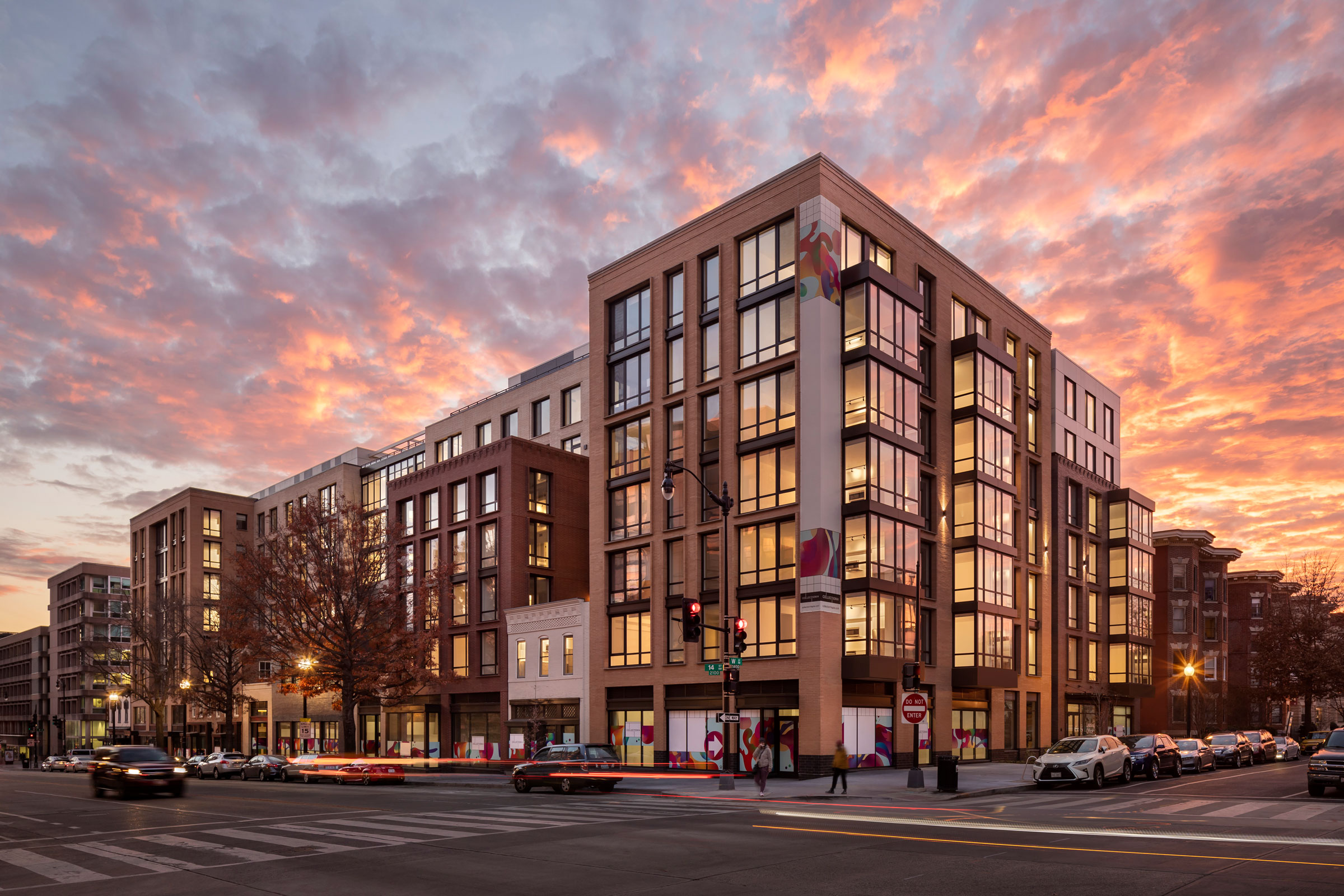Story at a glance:
- A building’s facade encompasses the entire front or street-side face and includes everything from the windows and cladding material to its decorative elements.
- Panel, curtain wall, closed cavity, prefabricated, ventilated, and green facade systems are among the most popular facade styles in contemporary architecture.
- Widely regarded as one of the most energy-efficient facade systems, ventilated facades feature an air cavity that helps remove hot air during the summer and retain warm air in the winter.
The exterior of a building is your project’s first impressions. The design of a building’s facade should not only comply with local regulations but also with a client’s maintenance needs, aesthetics, and sustainability demands.
“A facade is far more than the protective shell of a building. Its design not only characterizes the building itself but also influences the urban environment,” Lisa Burling, national sales manager at Agrob Buchtal, said in a previous gb&d story.
Let’s explore the history of facade design in the United States, the transition to less stylized and more integrated facade systems, and some of the materials commonly used in modern facade construction.
What is a Building’s Facade?

Binswanger Glass of Charlotte, North Carolina’s contract division installed the curtain wall facade in this 10-story mixed-use building in downtown Raleigh. One Glenwood sits at one of the highest elevations in the city at the intersection of Raleigh’s two most prominent streets—Glenwood Avenue and Hillsborough Street. Photo courtesy of Binswanger Glass
The French loanword “facade” comes from the Italian “facciata” and translates to “face” or “frontage.” When used in the architectural sense facade generally refers to the front-facing or street-facing side of a building and encompasses everything from the material itself to pillars, windows, cornices, gables, and other intentional design elements.
From a practical standpoint a building’s facade serves first and foremost as a means of shielding the interior from the elements, though it also serves an aesthetic purpose, as the building’s owner may express the structure’s overall character and function.
Facade vs. Cladding
While the term facade is often used interchangeably with “cladding,” the two terms refer to different things:
- Facade. A building’s entire front-facing or street-side face; includes the materials, windows, doors, trim, cornices, gables, balconies, pillars, columns, and any other intentional design features.
- Cladding. The actual material that makes up a building’s envelope and protects its entire exterior, rather than just the front-facing side.
In essence cladding is just one component of a facade system and does not describe the entire facade itself. The two terms are undeniably intertwined, however.
The History of Facade Design in the US
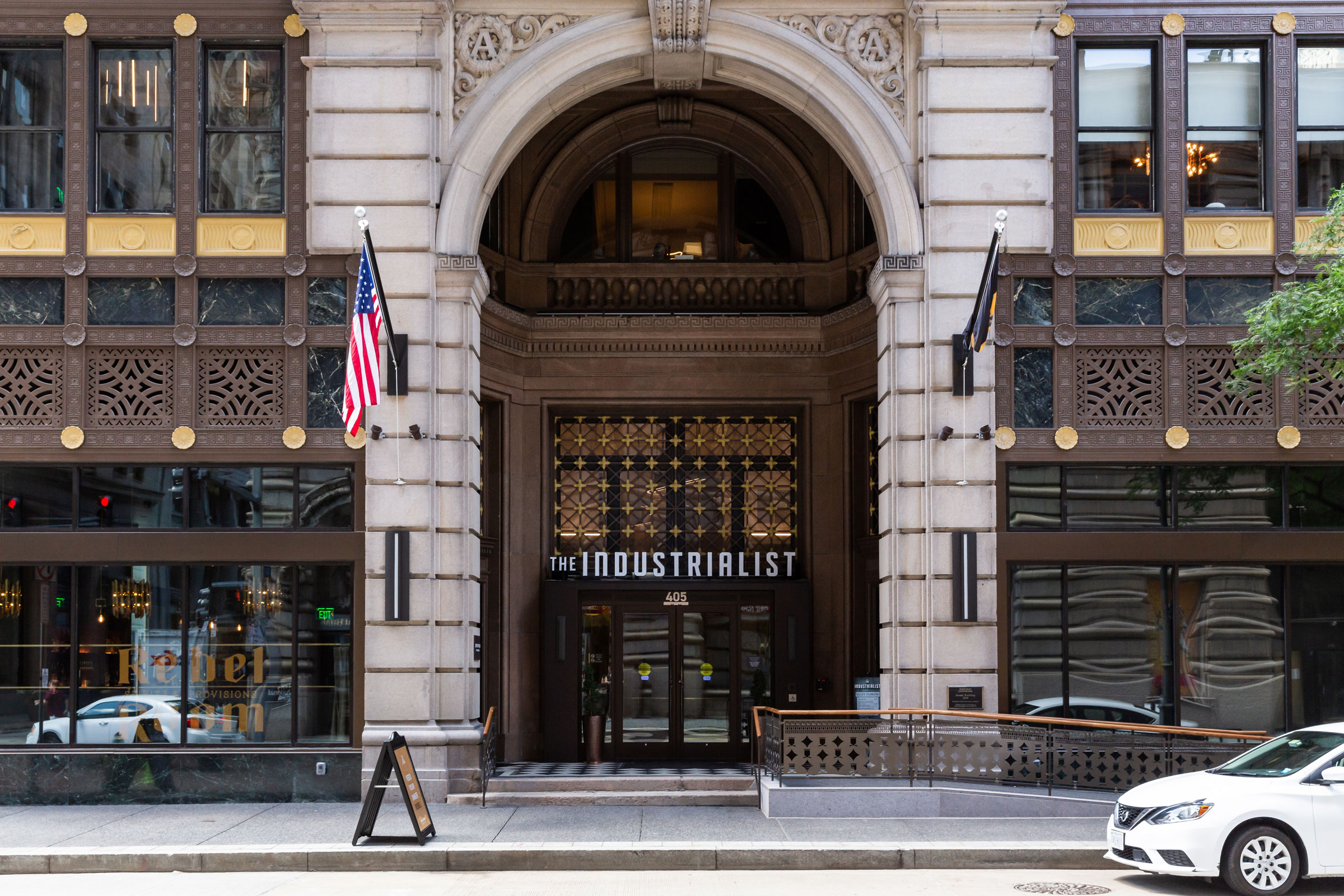
The Industrialist Hotel’s historic facade holds rich architectural details, including a Cornice crown with howling masks and a brick and terra-cotta–striped facade on a granite base. The design team completed significant restoration work at the building’s cornice, repairing and replacing structural steel that had been compromised by water infiltration. Photo by Digital Love Studios
Historically facade design and stylization has been informed by the predominant architectural styles of a place and time—and over the last few hundred years the US has favored a number of distinct architectural styles, many of which were characterized by the design elements implemented in their facades.
During the 18th century the most recognizable and widespread architectural style was the Georgian style, whose facades were characterized chiefly by symmetry—both in form and window placement—brick or stone cladding, corner quoins, a gabled roof, a pediment above the front entry, and a transom window over a paneled front door.
Shortly after the Revolutionary War the Georgian style would slowly decline until it was almost entirely replaced by—or rather, absorbed into—the Federal style of architecture. Heavily influenced by the buildings of ancient Greece and Rome, the Federal style facade is characterized by symmetrical form and fenestration, pillars or columns, delicate classical details, cornices with decorative moldings, an elliptical fan light over a paneled front door, side lights to each side of the door, an entry porch or front door crown, and flat lintels over double hung windows.
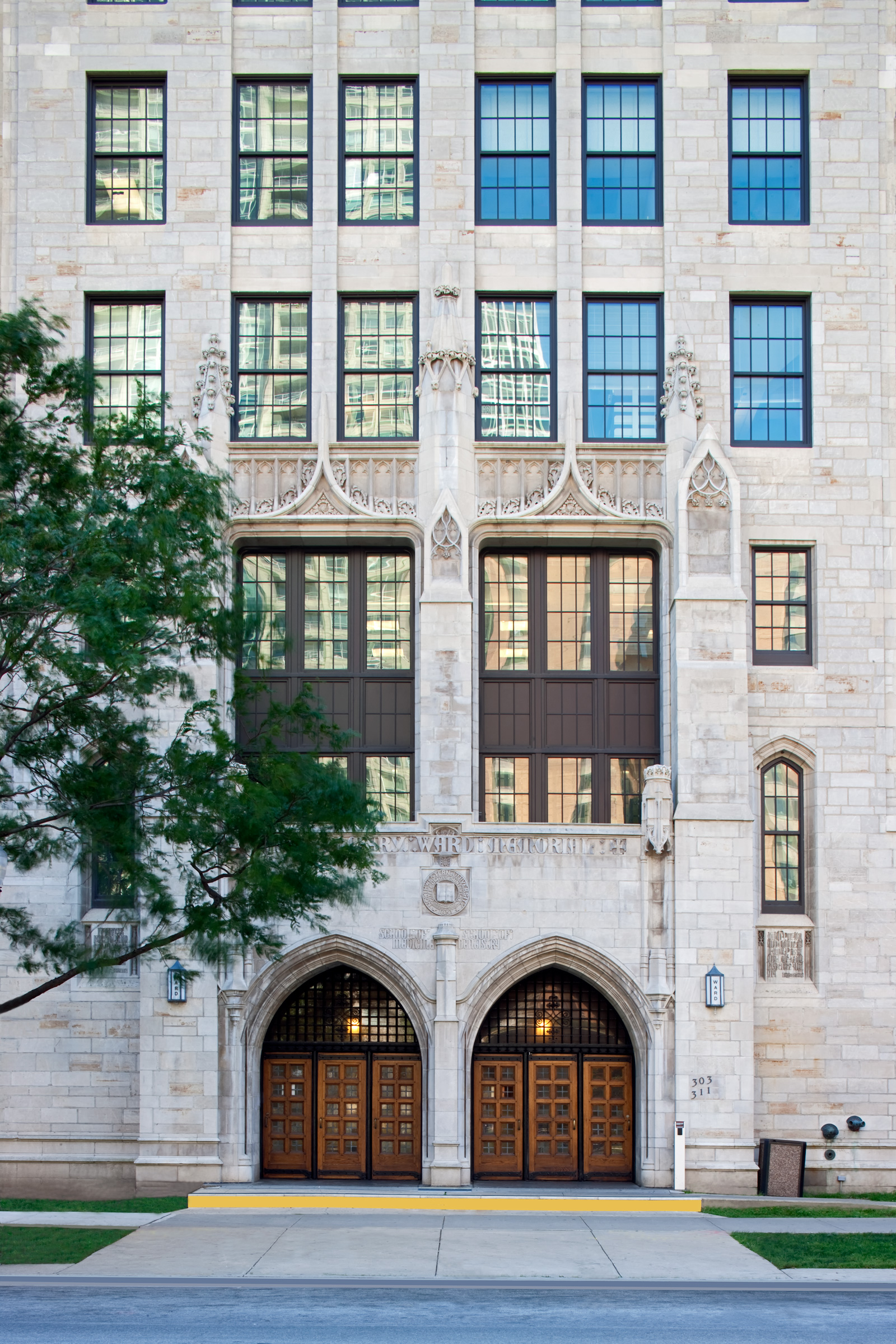
The Montgomery Ward Building on the Northwestern University campus implements Gothic Revival design elements in its facade. Photo courtesy of Kawneer
Throughout the mid-to-late 1800s the Gothic Revival movement—inspired by the architecture of medieval Europe—would largely supplant the Federal style of architecture, especially with regard to the design of churches, schools, and even private residences. Facades constructed in the Gothic Revival style often featured ornate details and were characterized by stone or brick walls, castle-like towers, decorative gable or drip-mold crowns over the windows and doors, pointed arch windows and doors, and porches bearing slender columns or decorative turned posts.
Technological advancements throughout the late 1800s and early 1900s eventually gave rise to early skyscrapers, many of which incorporated elements of the aforementioned Gothic Revival style in their facades, solidifying their conceptualization as “cathedrals of commerce.”
Over the last hundred years or so facade stylization has become much sleeker and more minimalist, especially with regard to skyscrapers, high-rises, and other large-scale commercial buildings. By all accounts this can be described as a natural evolution stemming from the adoption of the Early Modernism, Federal Modernism, and International architectural styles throughout the mid-1900s, all of which favor simplicity, geometrics, and increased window area over ornamentation and decoration.
This transition toward simplicity gave rise to several distinct facade solutions, or integrated systems encompassing both the structural features and elements used to protect the building envelope, as described below.
Types of Facade Systems
These are some of the most popular facade systems currently in use.
Panel Facades
In its most basic form, a panel facade system typically consists of posts, transoms, and panels, the latter of which can be made from a variety of light- or heavy-weight materials. Each panel is affixed directly to the wall itself at multiple points, allowing for optimal support.
Panel facades can be constructed from a variety of materials, such as:
Ceramic Panels
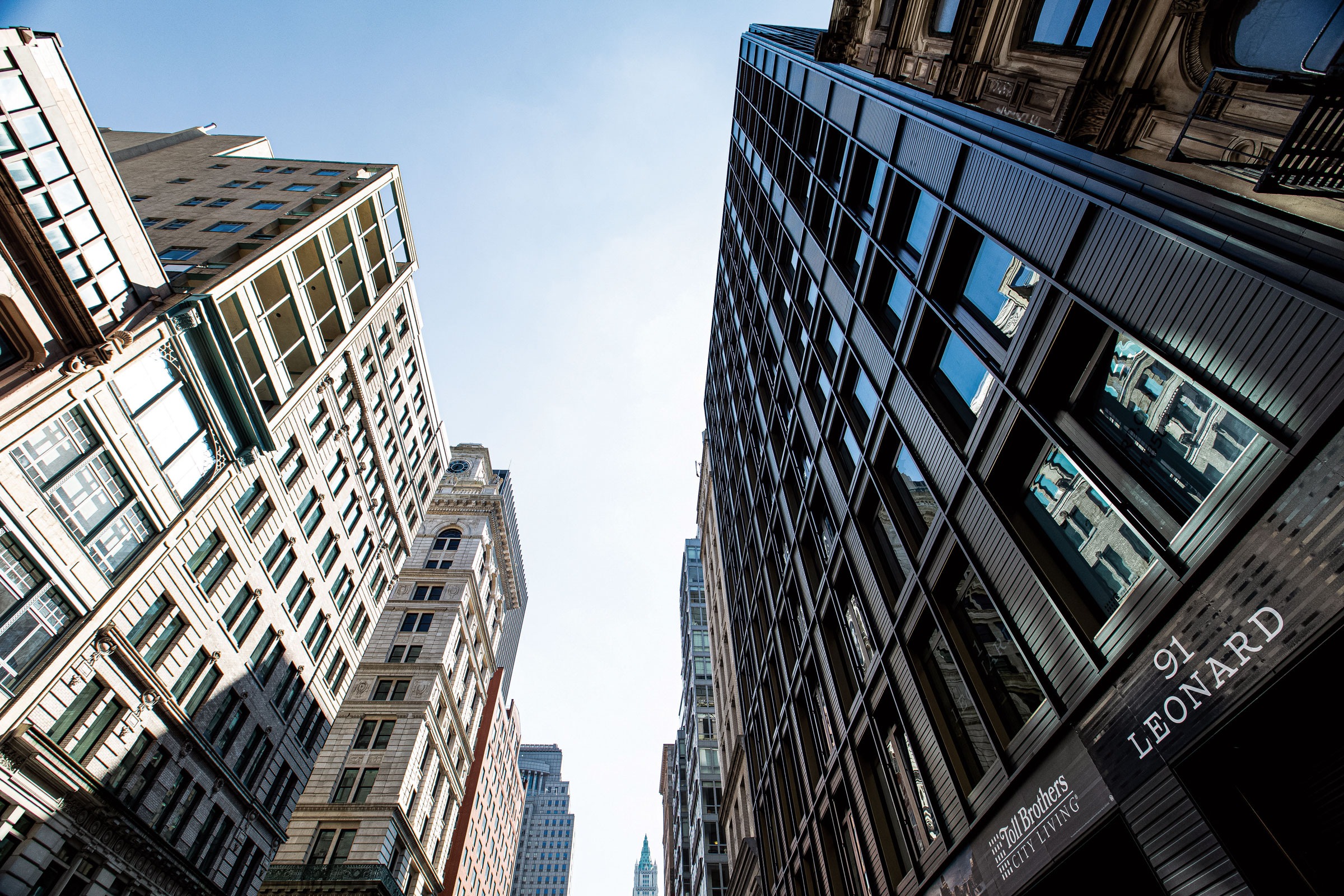
At 91 Leonard Street in NYC, developers used KeraTwin and KeraShape ceramic panel facade system to complement the 19th-century warehouses and lofts of the surrounding neighborhood. Photo courtesy of Agrob Buchtal
Due to their low-carbon status, ceramic panels—also known as terra-cotta—have seen a resurgence in their use as a cladding material for building facades. Experts say the entire process of manufacturing, construction, operation, and deconstruction for terra-cotta is exceptionally sustainable. It also helps provide an additional shell for buildings, proving beneficial in terms of energy efficiency.
Ceramic cladding is most attractive to clients who want a distinct and attractive facade that can withstand both time and weather while undergoing little to no maintenance, according to Craig Dudley, sales manager for the Innovative Building Products division of Acme Brick.
One of the best uses for terra-cotta facades are in historic renovation projects, as terra-cotta facades can be installed directly on any existing facades, though experts say they’re also easy to incorporate in new construction.
Natural Stone Panels
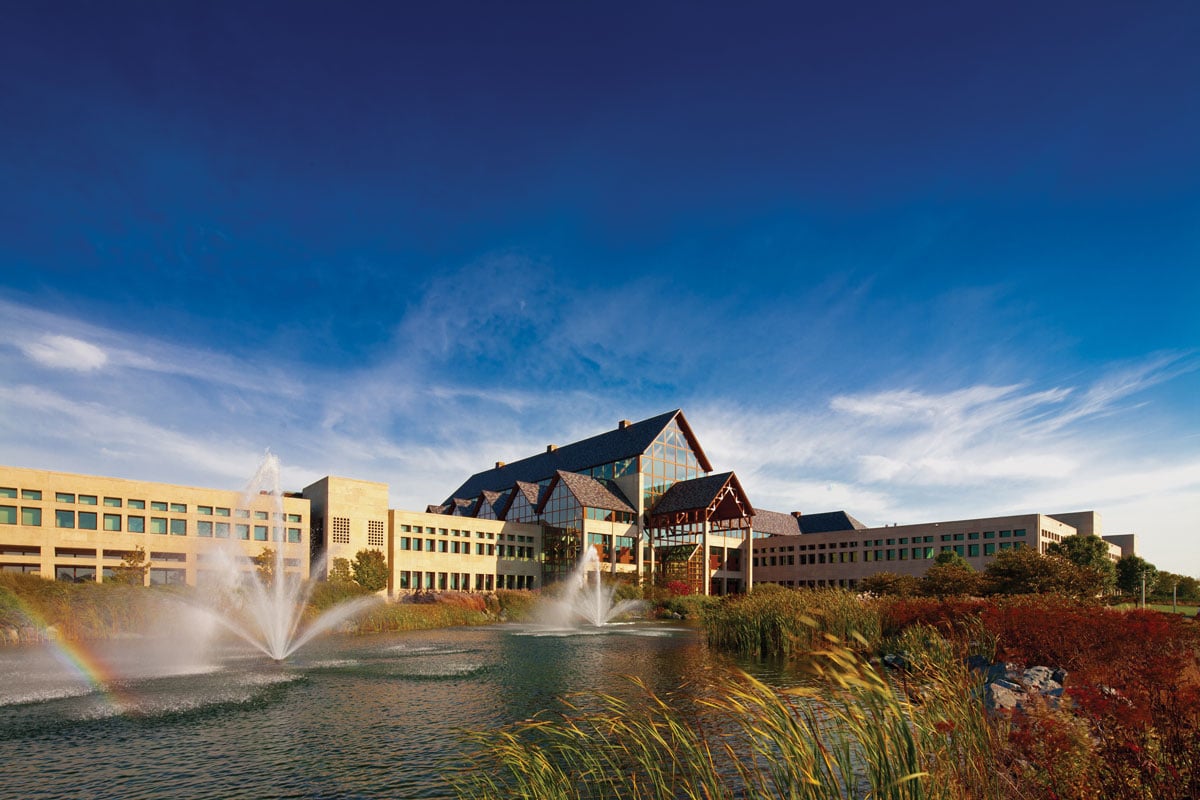
Architects used 55,000 square feet of Biesanz MDL with Natural Stone Panels for the exterior of the Acuity Insurance Headquarters in Wisconsin. Architects used 55,000 square feet of Biesanz MDL with Natural Stone Panels for the exterior of the Acuity Insurance Headquarters in Wisconsin. Architects used 55,000 square feet of Biesanz MDL with Natural Stone Panels for the exterior of the Acuity Insurance Headquarters in Wisconsin. Photo courtesy of Biesanz Stone
Natural stone panels from Biesanz Stone aim to be an affordable, sustainable option in the world of exteriors. The prefabricated panels are built under optimal conditions, are ready for installation when the supporting structure is complete, are lightweight, durable, cost-effective, and versatile in design.
Biesanz says its mission is to enable customers to use the natural, low-energy product at a competitive price—with prefabricated natural stone panels that enhance a building’s facade or add flair to an interior.
Stone comes from the ground, reducing production costs, too. “We don’t have the cost associated with creating the product, and we aren’t using the substantial amounts of energy it takes to create cement-based products, much less to cut it to size and shape it,” said Darrell Stahlecker, president of Biesanz Stone, in a previous gb&d article. “It’s a stand-alone resource.”
Stone Composite Panels
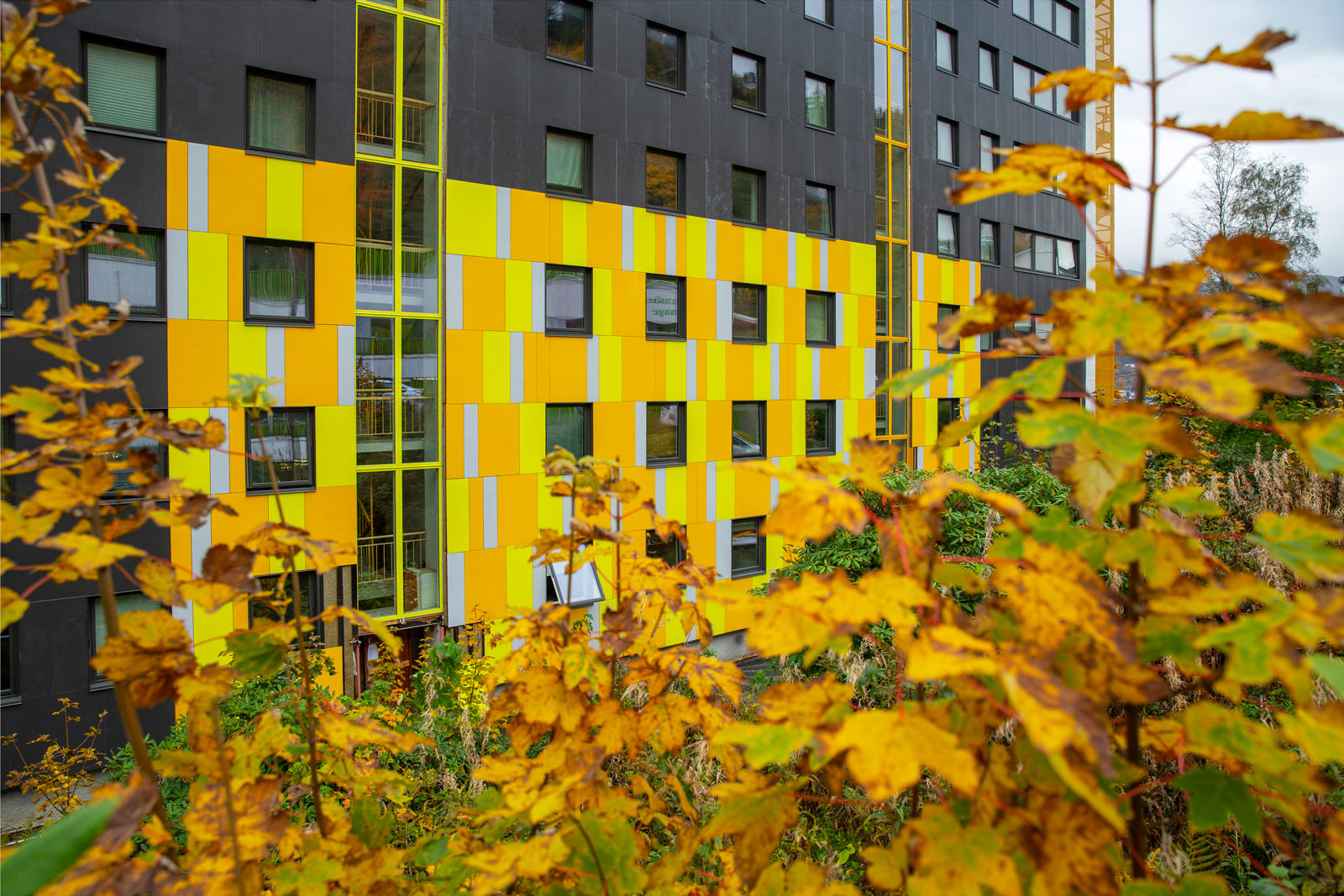
Architect Lena B. Keilegavlen of Cubus says this facade is inspired by the Norwegian mountainside. “As a contrast and identification, each house has a main color inspired by the colors of leaves during shifting seasons.” Photo courtesy of Arkitektgruppen Cubus AS
Steni Colour panels are stone composite panels that come in more than 60 standard colors with three gloss levels, or they can be custom-ordered to contain any color based on NCS or RAL. Their pre-cut formation allows them to be of variable dimensions and offer very little wastage.
These panels can be seen in the Solheimslien Housing Project in Bergen, Norway. The colorful facade was chosen due to its easy installation any time of year with minimal maintenance requirement. They can be cleaned with common household materials, while their durability makes them impact-, frost-, and water-resistant.
“The buildings are located in a moist climate, close to a mountain side, and do not have much sunlight,” Architect Lena B. Keilegavlen of Cubus previously told gb&d. “In the wet climate of Bergen this location is exposed to growing of moss and fungi. The new facades needed to be smooth and hard to prevent growing, and easy to clean.”
Metal Composite Material (MCM) Panels
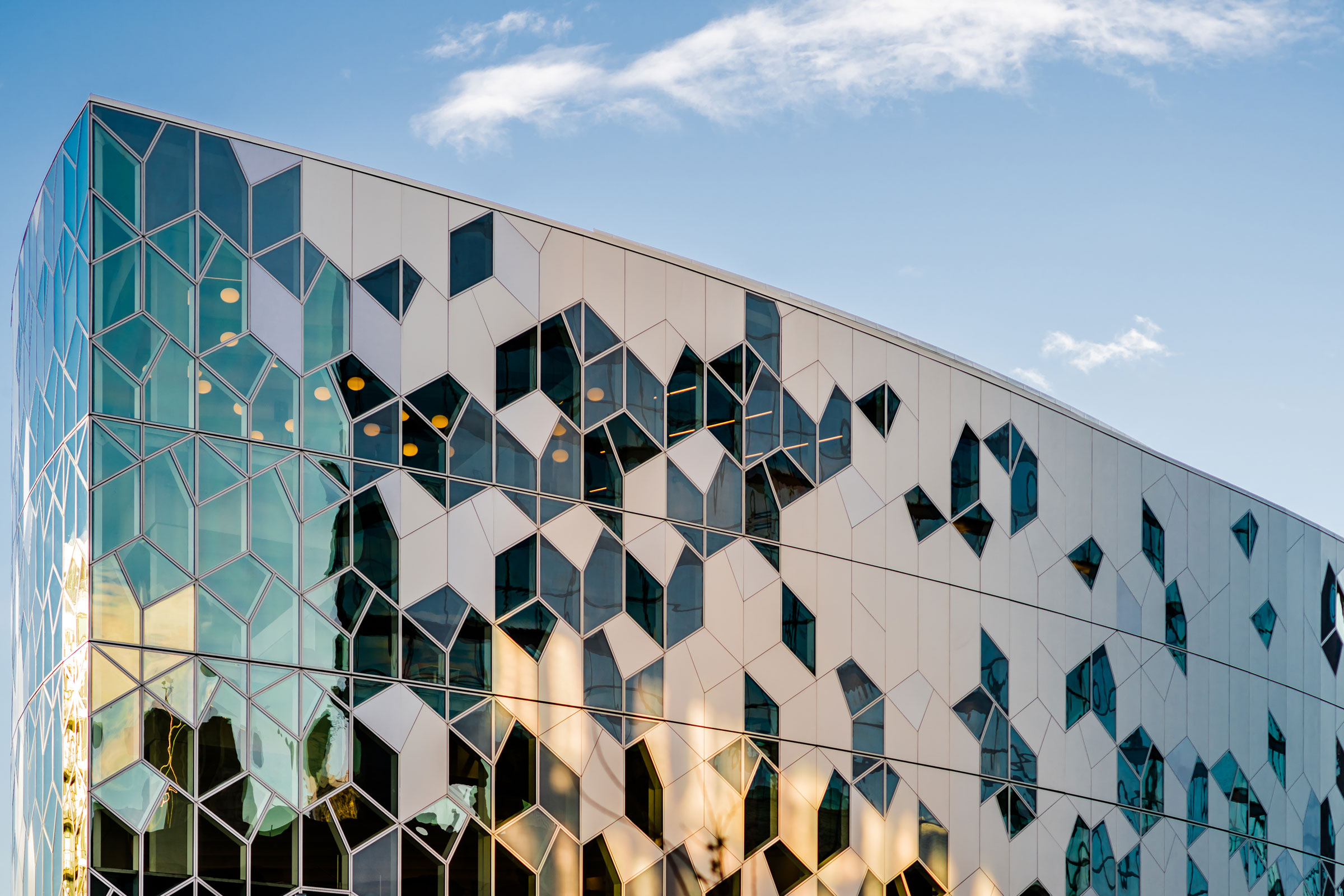
Interspersed with the glass and natural wood accents, ALPOLIC MCM creates a lace-like effect across the building’s facade. Photo courtesy of MCA-ALPOLIC Division
Constructed from two thin sheets of metal (e.g. aluminum, copper, stainless steel, zinc, etc.) bonded to a thermoplastic core, MCM is a cost-effective facade system solution that more and more architects are turning to. Lightweight MCM panels can be easily molded into an array of complex shapes, finished in a wide variety of colors, and ultimately make for an incredibly durable cladding option that, when combined with air and water barriers, creates a high-performance building facade.
“Introduced to the world more than 50 years ago, American manufacturing and architectural use of MCM has taken hold over the last three decades,” Michael Bowie, technical support specialist at MCA-ALPOLIC Division, previously wrote for gb&dPRO. “First incorporated into gas station canopies, painted aluminum composite material (ACM) offered a lightweight, uniform look for the biggest petroleum brands who needed easy fabrication, reliability, and custom matched finishes for their corporate identity colors.”
Bowie says these panels can be prefabricated off-site, shipped, and installed much quicker than alternative products, greatly reducing construction times. “These systems could require less structural investments, like reduced steel needs because of the lighter load in the wall assembly. Though only one-fourth to one-third as much metal as comparable one-eighth inch sheet metal, composites impressively retain their rigidity and strength.”
Curtain Wall Facades

The Harrison Path Train Station in Harrison, New Jersey leverages YKK AP subsidiary Erie AP’s ENVIRO|FACADES unitized curtain wall. Photo courtesy of YKK AP
Curtain wall facades, on the other hand, pass around a building’s framework and are self-supporting, which means they are non-structural and do not aid in supporting a building’s dead load. Dor this reason curtain wall facades can be made from lightweight materials like aluminum.
Curtain wall facades typically consist of a framework/mullions (traditionally either steel or aluminum), an infill material, and weatherproofing features. In contemporary architecture glass is the most widespread infill material used in curtain wall systems as it is relatively inexpensive and allows for ample daylighting opportunities, though metal panels, stone veneer, operable vents or windows, and louvers are also commonly used as infill materials.
Because they are designed to span multiple floors and are capable of transferring lateral wind loads to the main structure, curtain wall facades are typically implemented on skyscrapers and high-rise buildings.
Closed Cavity Facades
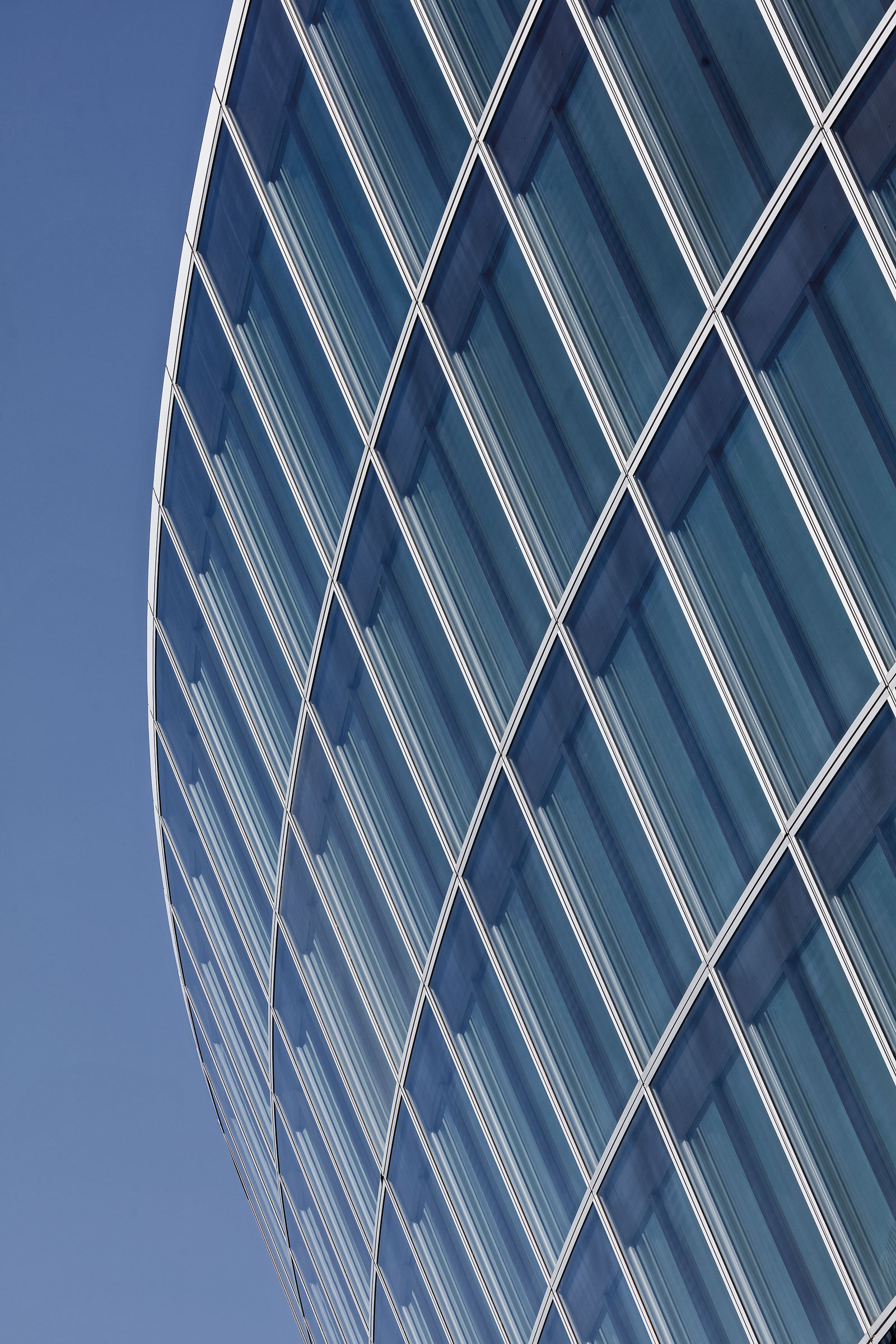
Photo courtesy of Permasteelisa
A variation of the traditional curtain wall system, closed cavity facades (CCFs) are a type of facade made with two types of glass for the exterior and interior with a cavity between them to prevent condensation. Inside the cavity, solar shading devices and controls monitor exterior conditions, control the shade, and regulate the flow of dry air into the cavity.
CCFs allow for excellent thermal performance in the transparent areas, provide a high degree of solar protection by the automated blind system, lower maintenance costs, result in lower degree of asymmetric temperatures at the building perimeter, improve acoustic performance, and increase the life expectancy of the glazing units, according to experts. In fact, Derick Koprek, lead concept designer at Permasteelisa Group, told gb&d CCFs are the future of curtain walls.
Precast & Prefabricated Facades
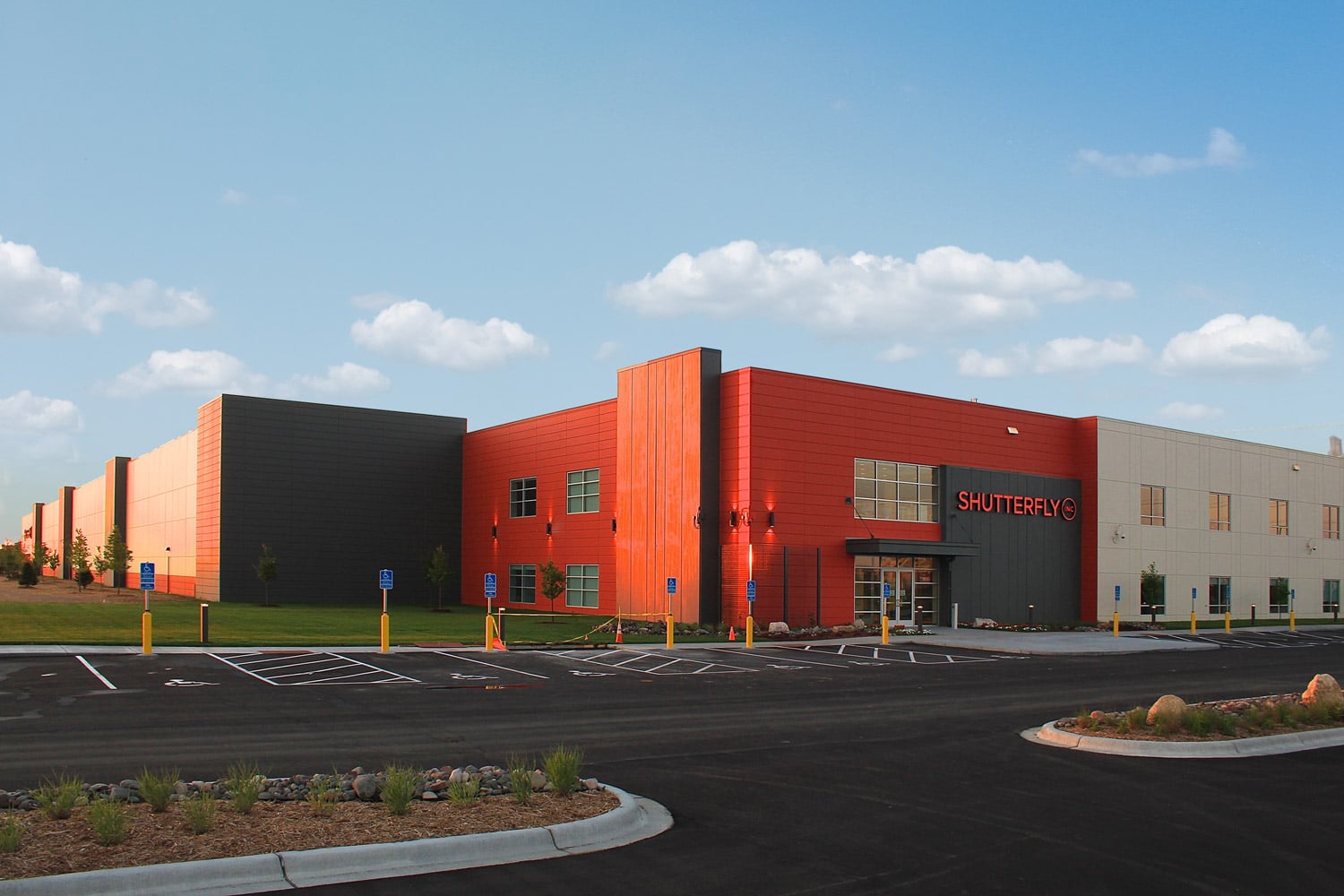
Shutterfly’s Customer Care and Design Production facility show how precast concrete can stand out with color. Photo courtesy of Fabcon
Another type of facade that has risen in popularity over recent years is the precast or prefabricated facade, of which consists of pre-made modules that are joined and assembled on-site—a characteristic that greatly reduces overall construction time. Most prefabricated facade modules are made from concrete, making them an extremely durable, if not incredibly heavy, option.
Fabcon’s precast concrete panels, for example, are known for their quick and easy installation, resilience to weather, and as an affordable, sustainable option in new builds. Fabcon says it prides itself in taking a “functional aesthetics” approach, meaning performance should not come at the cost of appearance. By mixing four primary colors—light red, dark red, yellow, and black—they can create many different matrix colors.
Fabcon aims to lower costs for clients by sourcing the materials for its aggregates locally. “We can utilize a combination of two colors of cement, gray, or white in the concrete mix, and over 50 different limestones, quartzes, and granites for stones and sands to create different colors and looks,” said Rich Mantel, Fabcon’s materials engineer, in a previous gb&d interview.
Ventilated Facades![]()
Sometimes referred to as rainscreen cladding, a ventilated facade consists of an external load-bearing wall, insulation, and cladding panels affixed via a supporting structure (anchors), similar to some panel facade systems. The main difference between the two is that ventilated facades feature a 30 to 80mm thick air cavity between the wall itself and the cladding material—a characteristic that greatly improves a building’s overall energy-efficiency.
During the summer months, this air gap results in the so-called “chimney effect,” or the natural convection phenomenon by which hot air rises and escapes through the top of the facade, allowing for constant circulation of fresh air—which in turn helps prevent overheating and reduces air conditioning usage. During the colder months, air that enters the cavity does not warm up as much and so remains inside the gap, where it acts as an additional insulation layer, thereby reducing heating costs.
Ventilated facades also help prevent the buildup and infiltration of moisture into a building’s walls, as the air cavity aids in removing water vapor as well as heat.
Green Facades
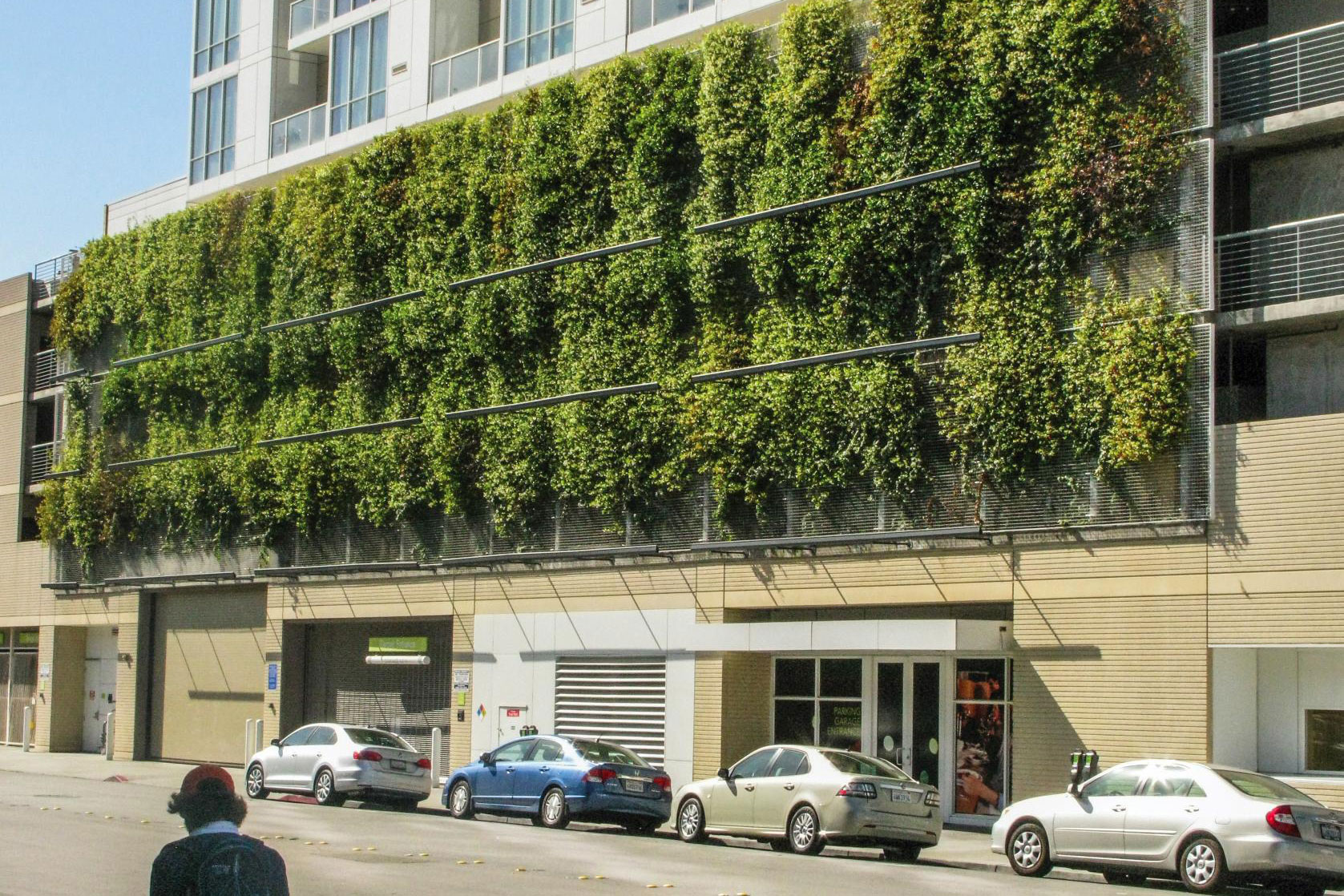
The Ellington in Oakland, California makes use of a green facade to help diffuse sunlight and redirect solar energy. Photo courtesy of Greenscreen
Though they aren’t widely known or implemented, green facades are capable of giving life to any space or structure and serve as an integral component of contemporary sustainable architecture. Using vertical trellis panel and planter combinations, green facades can help encourage biodiversity and provide a planted alternative to conventional concrete barricades, plexiglass, or other hard surfaces.
Due to their lightweight and non-intrusive nature, green facades can, for the most part, be installed overtop of most existing facade systems with little to no alteration. Today Greenscreen is one of the leading manufacturers of green facades and living walls, in large part due to the versatility and ease-of-installation of their products.
“Greenscreen trellis panels can be attached directly to a building wall as a retrofit solution for existing structures,” Charlene Mortale, division vice president of product management at Greenscreen, previously wrote for gb&dPRO. “The same panels can also attach to posts or other types of steel structures as a freestanding element. These welded wire panels weigh less than a pound per square foot and have a 3-inch thickness, which is ideal for growing vines up from the ground to populate the panel without adding much weight to the building envelope.”
Green facades are great for establishing different areas and settings in a physical space, while also helping to naturally regulate interior temperatures, filter light, and combat the urban heat island effect.
Rafael Picó contributed to this article.

